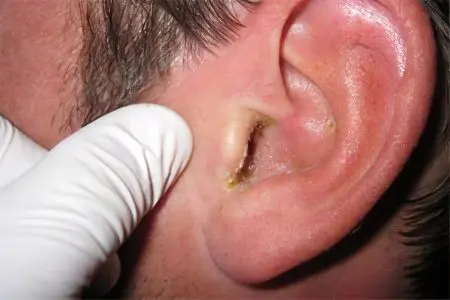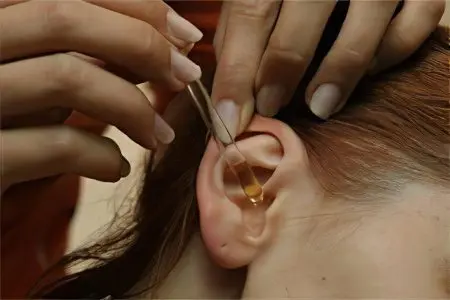
A fungus in the ears is an infection that is caused by mycotic organisms that can affect the structures of both the outer and inner ear, or the mastoid cavity formed after a mastoidectomy.
The fungus in the ears is a fairly common disease, more often it is diagnosed in childhood – in 27% of cases of the total number of otitis media and in 18% of cases in adults. The hotter and wetter the environmental conditions in which a person lives, the more common the fungus in the ears. The fungus is diagnosed with the same frequency in men and women. A separate risk group is made up of people who have undergone ear surgery and patients who use a hearing aid.
Everywhere, otolaryngologists note an increase in the number of patients with mycotic lesions of the ENT organs. They attribute this primarily to the uncontrolled use of local antibacterial drugs to get rid of otitis media. In the vast majority of cases, the disease is provoked by yeast-like fungi of the genus Candida. The proportion of mold fungi is not too high. In addition, a mixed fungal or fungal-bacterial infection is possible.
Most often, ear damage is unilateral. Bilateral infection is diagnosed only in 10% of cases.
Ear fungus symptoms
The symptoms of ear fungus will vary depending on which part of the ear is inflamed. They tend to increase as the mycelium of the fungus grows into the deep structures of the skin. This has not only a mechanical injury, but also contributes to the enzymatic and toxic pathogenic effects.
Symptoms of external fungus in the ears. The development of the disease is preceded by the loss of the fatty film that lines the skin of the ear canal. This can happen due to the application of microtrauma, or as a result of high humidity of the environment. The ear canal swells, the glands located in its skin are clogged. At this time, the patient begins to experience a feeling of itching and congestion in the ear. Most often, people believe that the cause of such discomfort is a sulfur plug or ear pollution and try to clean it on their own, while violating the integrity of the skin and facilitating the penetration of a mycotic infection. As a result, the patient develops acute otomycosis, which increases swelling and hyperemia of the skin of the outer ear.
The acute stage of the disease is characterized by the presence of secretions, the volume of which is constantly increasing. The color of the discharge may vary, depending on the characteristics of the causative agent of the fungal infection. When it is provoked by mold fungi, the exudate will look like caseous masses, somewhat reminiscent of wet paper. The shade of these masses is either black-brown, gray-black, or yellowish-green. With penicillosis, the color of the discharge resembles the color of earwax.
If the edema is strongly pronounced, then the lumen of the ear canal is completely blocked. As a result, a person hears noise in the ear and suffers from severe hearing loss, as the sound hardly reaches the eardrum.
Pain of pronounced intensity always accompanies the acute stage of the fungus of the outer ear. The pain tends to increase during shaving and when swallowing. Together with the secret coming out of the ear, casts can be isolated from it, which contain fungal mycelium and cells of the epidermis of the ear.
Often there is regional lymphadenitis, that is, inflammation of the lymph nodes, which extends to the temporomandibular joint and the parotid gland. It is possible to involve the middle ear cavity in the pathological process, which often occurs in patients with diabetes mellitus or leukemia.
Symptoms of a fungal infection of the middle ear. This disease develops against the background of an already existing chronic inflammation of the tympanic cavity. Patients complain of a deterioration in well-being, which is primarily manifested in ear pain. In addition, there is a pronounced hearing loss, extraneous noises appear and a feeling of congestion arises. Sometimes there are periodic headaches.
Symptoms of a fungal infection of the eardrum. With fungal miringitis, the process spreads even deeper and captures the eardrum. Hearing falls sharply, as the mobility of the membrane is disturbed. This occurs against the background of discharge from the ear, severe pain and other symptoms of inflammation.
Symptoms of fungal infection of the postoperative cavity. When the patient underwent a mastoidectomy, mycotic inflammation may begin in the resulting cavity, where the cells of the mastoid process were previously located. Arising pains are localized in the behind-the-ear region, as well as in the ear itself. The volume of allocations increases significantly. At the same time, patients often ignore the appeal to the doctor, as they consider such pain to be normal in the postoperative period.
Causes of fungus in the ears

Most often, the saprophytic flora becomes the cause of damage to various parts of the ear. These are those mycotic organisms that normally always exist on human skin and do not show pathological activity in the absence of predisposing factors.
So, the main causes of fungus in the ears are considered to be:
Foreign bodies of the ear. It can be any foreign object. Most often, this reason becomes a trigger for the development of mycotic otitis media in childhood. Children put pebbles, pieces of paper toys, plant seeds, plasticine, cotton wool, etc. into their ears. In adulthood, foreign bodies get into the ear by accident, for example, due to injury. As for older people, parts of a hearing aid and batteries from it are more often found in their ear. Also, a fungus in the ears can develop due to water getting into the ear.
Ear injury. This includes injuries to the outer, middle, and inner ear. Most often, the toilet of the ear canal with a cotton swab leads to microtrauma and causes disease.
Enhanced work of sweat glands.
Infection with fungi of the genus Candida with genital candidiasis, or with skin candidiasis.
Combing the auricle, which most often occurs with various dermatitis (with contact, atopic dermatitis, with eczema).
Non-compliance with the rules of ear hygiene, its pollution, or alkalization of the cover of the external auditory canal.
The narrowness of the ear canal, the presence of exostoses.
Local dysbacteriosis can lead to disruption of the normal microflora of the ear. Especially often this happens after various types of otitis media.
Taking antibacterial drugs, washing the ear with antibiotic solutions also contributes to the disruption of normal microflora.
A decrease in the immune forces of the body, a violation of metabolic processes, allergic reactions are always risk factors for the development of a fungal infection, including in the ear.
Wearing a hearing aid and frequent use of headphones can also pose a risk in terms of developing the disease.
Ear fungus treatment

In order to get rid of the fungus in the ears, it is necessary to use antimycotic drugs. To do this, the middle and external auditory canal, as well as the postoperative cavity, are washed with various antimycotic drug solutions. The toilet of the ear is preliminarily performed – it is cleaned of the desquamated epidermis, of the existing secretions, of sulfur and mycelium of the fungus.
To determine the choice of a suitable remedy, it is necessary to establish the type of fungus that causes inflammation:
The toilet of the ear is also carried out with the help of various medicinal and antiseptic solutions. Any accumulation of exudate or caseous masses is a powerful source of fungal infection, so they must be removed with great care. It is possible to use hydrogen peroxide, a solution of Boric acid 3%. It is possible to lubricate the skin of the ear canal with a 5-10% solution of silver nitrate.
The drug of choice for local treatment is chlornitrophenol and 1% solution of naftifine. The preparations are used as applications on the skin of the external auditory canal for 10-14 days. It is also possible to put ointments in the ear – Nystatinova and Levorinova. Sometimes the solutions are instilled directly into the ear (if the eardrum is not damaged), and sometimes they are applied to cotton wool and inserted into the external auditory canal.
If Candida fungi are isolated during mycological culture, then applications are prescribed with a combination of drugs: 1% clotrimazole solution and 1% naftifine solution for 10-14 days with continued therapy for 14 days.
In case of insufficiency of local treatment, or in case of recurrence of the disease, local therapy should be supplemented by taking systemic drugs. Fluconazole is recommended.
Surgical treatment of ear mycosis is possible in the case when complications such as mastoiditis and chronic cholesteatoma with secondary otomycosis develop against its background. Also, the operation is indicated if it is impossible to get rid of the fungus in the postoperative cavity with conservative means.
Therapy of the fungus in the ears is not an easy task, but the prognosis is most often favorable, especially when the patient seeks medical help in a timely manner. If the fungus in the ears is localized in the middle ear and its cause was the adhesive process, then hearing loss may be irreversible. With a severe course of the disease, the fungus in the ear can lead to the spread of mycotic lesions to the internal organs and cause fungal sepsis. Therefore, therapy should be not only timely, but also qualified.









